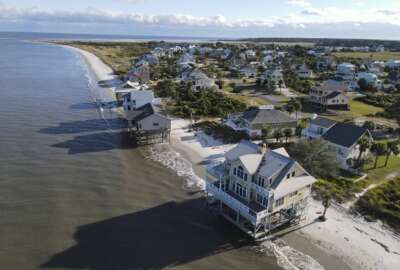Data centers pose prime opportunity to cut federal electricity consumption
Currently data centers account for approximately 2% of total U.S. energy use, equivalent to 10 to 50 times the energy per floor space of a typical commercial of...
To meet the White House’s goal of a net-zero carbon emissions electricity sector by 2035 and a net-zero economy by 2050, a lot of levers in the private sector need to come into play. Thankfully, deployment of low carbon energy has intensified and the costs of solar panels and wind turbines have decreased, according to Brian Anderson, director of the Energy Department’s National Energy Technology Laboratory.
NETL has been working on carbon capture and sequestration for at least 30 years before President Joe Biden’s executive orders on sustainability last year. One prime opportunity to cut energy consumption is at data centers, the demand for which is only expected to grow as government further embraces cloud computing and modernizes legacy IT. Currently they account for approximately 2% of total U.S. energy use, equivalent to 10 to 50 times the energy per floor space of a typical commercial office building, according to DOE.
“Data centers are some of the most energy-intensive type buildings and a lot of that comes to electricity. So if we focus on decarbonizing [the] electricity sector, we have huge components of our economy that we miss,” Anderson said during the General Services Administration’s Data Center Sustainability Summit this week.
The country needs more integrated energy systems to get off fossil fuels, Anderson said. Four years ago his lab, along with the Idaho National Laboratory, which specializes in nuclear energy, and the National Renewable Energy Laboratory in Colorado formed a consortium to build on hybrid energy systems.
The placement of federal data centers could also be a way to transform communities left behind by a waning fossil-fuel-based economy. Anderson used the Mineral Gap Data Center in Wise County, Virginia, as an example. The center reclaimed some former coal mine sites and is powered by solar energy, sparking local economic investment and investment in renewables.
Wise isn’t alone – several Virginia counties are trying to attract data centers in traditionally coal-dependent regions with strong solar and geothermal resources for electricity.
“And certainly, our colleagues at the Department of Interior are in the process of deploying billions of dollars — $11 billion in the Abandoned Mine Land Reclamation Program under the infrastructure bill — and billions of dollars in plugging orphan oil and gas wells around the country,” Anderson said. “These are truly opportunities to take an environmental legacy and turn it into economic opportunity.”
With about $62 billion of newly authorized funding for DOE in the infrastructure bill, NETL has a serious opportunity to leverage those reclamation projects for data centers. DOE is also releasing $19.5 million in awards for extracting sustainable critical minerals from coal waste, according to the initial report of the Biden administration’s Interagency Working Group on Coal and Power Plant Communities and Economic Revitalization.
Meanwhile, Anderson said the tri-labs also teamed up with the Pacific Northwest National lab to create a “net-zero laboratory initiative,” to reduce their scopes 1-3 emissions to zero over the next decade. This refers to emissions that directly and indirectly result from government activity.
“We will be working not only on site with decarbonizing our onsite usage, but with our power supply partners on driving forward the technologies that we have been developing in house and the Department of Energy with our partners,” he said. “And this is the call for partnership: I have the perfect audience here, we’ve been working with GSA on our power purchase agreements and many of our other sister federal agencies. There’s power in us putting all of our efforts together, there’s power — with the checks that we write through our power purchase agreements. And if we put our heads together, we can start driving the economy and creating the market that we need to see.”
Copyright © 2024 Federal News Network. All rights reserved. This website is not intended for users located within the European Economic Area.
Amelia Brust is a digital editor at Federal News Network.
Follow @abrustWFED






